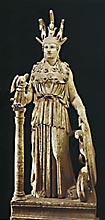The austere robustness of the early creators was succeeded by the gentle ripeness of the age of the Parthenon. Figures now expressed, through their beauty, the spirituality and range of the Classical miracle. All the Classical world's wisdom and deeply anthropocentric attitude is summed up in the tender idealization of these works, destined to influence the whole course of Western art.
The type of this statue is known from Roman copies. Other works by Phidias were: the colossal bronze of
Athena Promachus on the Acropolis, said to have been visible from Sunium; an
acrolith statue of Athena Areia, commissioned by the Plataeans; a votive bronze of Athena commissioned by the Athenian colonists on Lemnos; and a
Wounded Amazon. Some scholars also credit Phidias with the two
Riace Warriors, connecting them with the
group dedicated at Delphi by the people of Argos. Another view is that these statues were due to a similar group in the Agora at Argos and should be attributed to Alcamenes and Ageladas.




